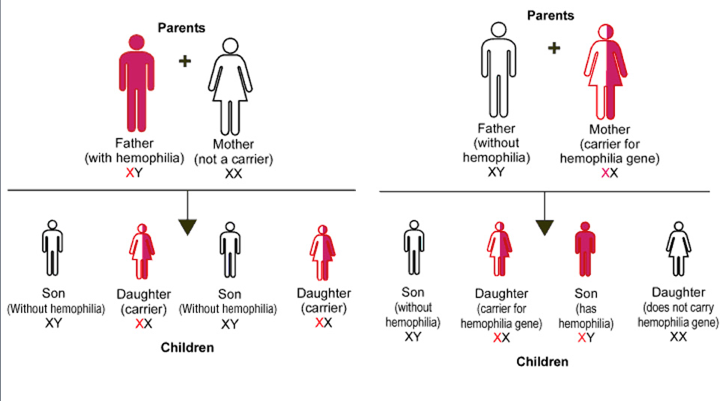Hemophilia was first described by the great Muslim physician Abu
al-Qasim al-Zahrawi in the tenth century when “writing of a family whose males
died of bleeding after minor injuries.”(Nilsson 1993). In 1803 Dr. John
Otto identified the disease as being hereditary (Nilsson).
The name Hemophilia comes from Friedrich Hopff in 1828, who originally called it “haemorrhaphilia" (Nilsson).
Hemophilia
is a disorder that interferes with an individuals clotting process. The
disorder causes a defect in the factor VIII
produced by a person, thus rendering their bodies unable to clot blood
properly. Symptoms of Hemophilia are: prolonged bleeding and
internal bleeding. There are two types of Hemophilia, A and B(rare)
– same symptoms, different mutation. The chromosome that the Hemophilia
disease is located on is the X chromosome - which is one of two sex
chromosomes. For a brief and simple genomic overview - Chromosomes are a
made up of a collection of genes, genes are a made up of a collection
of DNA, which is made up of building blocks called nucleotides. A
mutation, which is change in the nucleotide sequence of the genome, is
responsible for causing the Hemophilia disorder. The mutation leads to a
deficiency in the activity of coagulation factor.
Hemophilia is usually diagnosed when abnormal bleeding is observed
in a patient. To officially determine if a patient has hemophilia A
or B, specific assays of factor VIII and factor IX are performed. It is also
possible to diagnose hemophilia prenatally; by use of RFLP analysis, using PCR to determine if
restriction-site polymorphisms are present, “specific mutation analyses,
coamplification of polymorphic markers, direct sequencing of F8, and
haplotyping after multiple displacement amplification.”(Lavery, 2008) In
simpler terms specialist can examine the DNA of individual and see if the usual
suspects who cause Hemophilia are present.
Hemophilia is a recessive x-linked trait. Ultimately, this means
that men are more likely to have Hemophilia as males only inherit one X
chromosome from their parents while woman receive two. Woman would need two
defective X chromosomes to have hemophilia, which is incredibly unlikely. If a
woman had just one defective X chromosome, she would only be a carrier for the
disorder. Woman with one defective X chromosome have a 50% chance of passing
down the trait to her children regardless of gender. If a male has the
Hemophilia disorder he has a 100% chance of passing down the trait to his
daughters and a 0% chance of passing down the trait to his sons. Here is an
illustration of the hereditary of Hemophilia:
References:
ChristensenUniversity of Wisconsin-Madison, Allison.
"Phylogeny."Coagulation Factor VIII and Hemophilia A.
University of Wisconsin-Madison, 19 May 2013. Web. 19 July 2014.
Lavery, S. Preimplantation genetic diagnosis of haemophilia. Brit.
J. Haemat. 144: 303-307 (2008)
Nilsson, I. M. "[Haemophilia--then and now]." Sydsvenska medicinhistoriska sallskapets arsskrift 31 (1993): 33-52.

Which can be what's more a very good put in which definitely enjoyed exploring. A possibility per day which we accommodate the opportunity to understand a single thing. Anxiety And Stress Relief
ReplyDelete